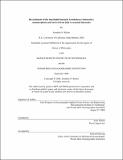| dc.contributor.advisor | Jesús Pineda. | en_US |
| dc.contributor.author | Blythe, Jonathan N | en_US |
| dc.contributor.other | Woods Hole Oceanographic Institution. | en_US |
| dc.date.accessioned | 2009-06-25T20:34:11Z | |
| dc.date.available | 2009-06-25T20:34:11Z | |
| dc.date.copyright | 2008 | en_US |
| dc.date.issued | 2008 | en_US |
| dc.identifier.uri | http://hdl.handle.net/1721.1/45609 | |
| dc.description | Thesis (Ph. D.)--Joint Program in Oceanography/Applied Ocean Science and Engineering (Massachusetts Institute of Technology, Dept. of Biology; and the Woods Hole Oceanographic Institution), 2008. | en_US |
| dc.description | This electronic version was submitted by the student author. The certified thesis is available in the Institute Archives and Special Collections. | en_US |
| dc.description | Includes bibliographical references. | en_US |
| dc.description.abstract | The benthic habitat is the terminal destination for marine animals in terms of their reproductive lifecycle. Recruitment dynamics relating to seasonal changes in the benthic habitat may be the best source of information for predicting recruit abundance and for marine resources management. The transition from the pelagic to the benthic phases is the last stage in the connectivity between benthic populations. The transition to the benthos may be a process that dominates recruitment dynamics to the exclusion of other characteristics of larvae such as their quality and their density. Recruitment of benthic marine animals is influenced by two seasonally varying factors of the benthic habitat. First, the availability of suitable habitat for recruitment can in large part determine the survival probability for settlers, a trend that is most pronounced for low or no survival when the settlement substrate is saturated by conspecifics from a recruitment cohort. Preemption is caused by the presence of current occupants from a recruit cohort, and it influences the settlement rate or the survival probability of conspecifics. Descriptive statistics (Chapter 2) and a field experiment (Chapter 4) highlight the role of preemption on barnacle recruitment. The second factor results from seasonal changes in environmental conditions that settlers experience in the benthic habitat, which could affect the physiology and survival probability of barnacle settlers. Highly unpredictable features of recruitment dynamics also play a role, such as wind that enhances wave action in the rocky intertidal that has been linked to the rate of settlement. Day to day variability in wind may cause patterns of settlement to be highly unpredictable. Predator induced mortality is spatially aggregated, and the random pattern of mortality in space is highly unpredictable. In contrast to these high frequency sources of recruitment variability, seasonal factors that vary at lower frequencies and that often change monotonically lend great predictive ability for recruitment dynamics. It appears that barnacles have evolved to compete for suitable habitat and have mechanisms to cope with seasonally varying environmental conditions in the benthic habitat, which may be the basis for why these features dominate the barnacle recruitment dynamic. | en_US |
| dc.description.statementofresponsibility | by Jonathan N. Blythe. | en_US |
| dc.format.extent | 125 p. | en_US |
| dc.language.iso | eng | en_US |
| dc.publisher | Massachusetts Institute of Technology | en_US |
| dc.rights | M.I.T. theses are protected by
copyright. They may be viewed from this source for any purpose, but
reproduction or distribution in any format is prohibited without written
permission. See provided URL for inquiries about permission. | en_US |
| dc.rights.uri | http://dspace.mit.edu/handle/1721.1/7582 | en_US |
| dc.subject | /Woods Hole Oceanographic Institution. Joint Program in Oceanography/Applied Ocean Science and Engineering. | en_US |
| dc.subject | Biology. | en_US |
| dc.subject | Woods Hole Oceanographic Institution. | en_US |
| dc.subject.lcsh | Benthic animals | en_US |
| dc.subject.lcsh | Recruitment (Population biology) | en_US |
| dc.title | Recruitment of the intertidal barnacle Semibalanus balanoides : metamorphosis and survival from daily to seasonable timescales | en_US |
| dc.type | Thesis | en_US |
| dc.description.degree | Ph.D. | en_US |
| dc.contributor.department | Joint Program in Oceanography/Applied Ocean Science and Engineering | en_US |
| dc.contributor.department | Woods Hole Oceanographic Institution | en_US |
| dc.contributor.department | Massachusetts Institute of Technology. Department of Biology | |
| dc.identifier.oclc | 319070202 | en_US |
